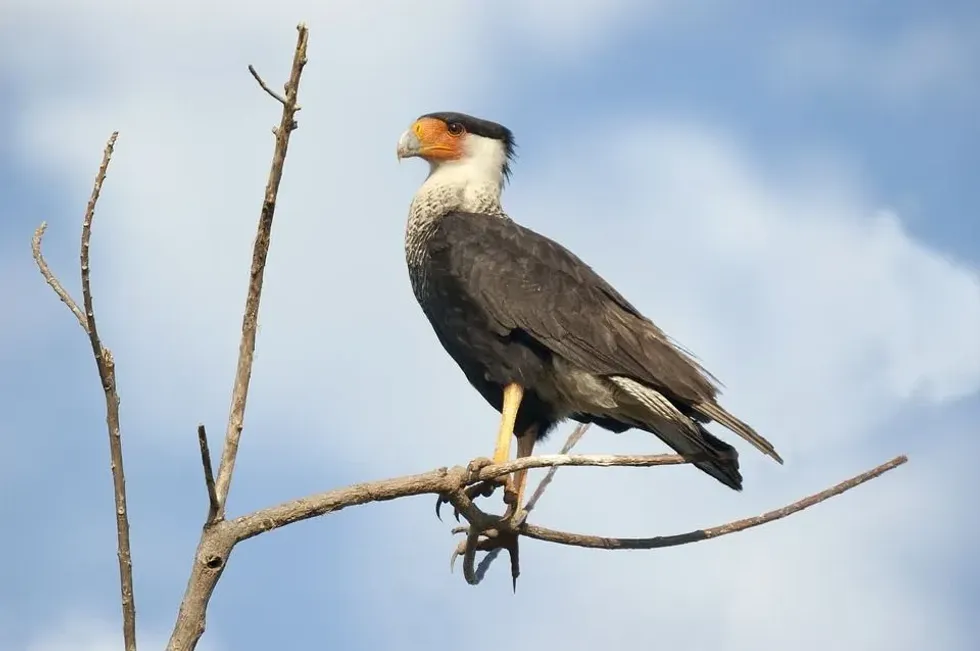Crested caracaras are birds related to typical falcons but behave like vultures. Even though they are related, the shape, appearance, and habits of crested caracaras are very different from their relatives.
The pattern of this bird is strikingly colorful, and its wingspan makes a crested caracara in-flight look broad. The bird mainly lives in pastures and grasslands.
The main food of caracaras is carrion, which is the decaying flesh of dead animals. This species of bird is highly opportunistic. It hunts and scavenges in various ways and eats almost anything it can find.
They also steal and snatch food from other birds in the quest to satisfy their hunger. Crested caracara often can be seen foraging with vultures on a carcass.
Crested caracaras can steadily both run and walk on the ground. They run a little before lifting in the air. January to March is the main breeding season for these birds.
They can be found in various climates such as tropical, temperate, and arid. This species of bird is diurnal and leads a sedentary lifestyle. To know more about the habitat, food habits, and appearance of this bird, read on.
If you find it interesting to read about this amazing bird, you may also want to check out some facts about Cooper's hawk and the common nighthawk.
Crested Caracara Interesting Facts
What type of animal is a Crested Caracara?
The crested caracara is a bird related to falcons.
What class of animal does a Crested Caracara belong to?
Crested caracaras are North American birds that belong to the class Aves and family Falconidae.
How many Crested Caracaras are there in the world?
The population of these birds is huge. There are more than 2 million crested caracaras present in the South American and North American regions. This population of North American birds decreases the conservation concern of crested caracaras.
Where does a Crested Caracara live?
Crested caracaras are usually found in the American tropics. For the crested caracara, Florida is the main region of living, as Florida is rich in wildlife.
Northern crested caracara range from South Florida to Central Florida, Texas, and Mexico.
This species of bird can basically be found in North America, and the Audubon's crested caracara can range from the regions near the Mexican borders and through Florida, but crested caracara distribution exists in South America and Central America as well. Southern crested caracara is a little rarer than the others.
What is a Crested Caracara's habitat?
The habitat of crested caracaras is open country, including pastures, grasslands, deserts, scrubs, savannas, and cultivated areas. This species can be found nesting in a range of habitats including wet prairies of Florida, deserts in Arizona, open terrains of American tropics, and coastal plains in Texas.
Who do Crested Caracaras live with?
Crested caracaras live in wildlife like prairies and savannas and hence live with a limited yet variety of animals. This is because they basically prey on the dead bodies of various animals. They often meet up to eat in pairs or groups of three to four, numbering up to 60.
How long does a Crested Caracara live?
The lifespan of these birds in the wild is unknown, but the oldest one of these birds lived around 24 years in Florida (where these birds are majorly found). In captivity, these birds have been known to live around 30 years.
How do they reproduce?
During courtship, these birds exhibit some behaviors like preening each other's feathers and tossing their head back while making a guttural call. During nesting, a pair takes almost four weeks to build a nest which is usually built around 10-50 ft above the ground on the top of a tree or shrub.
These nests are nearly six feet across and are built using twigs, debris, and weeds. They often refurbish and reuse old nests, which makes their nests even larger.
The females lay around three eggs, and sometimes even four, within one or two broods. The incubation period of the eggs is around 30-33 days. The breeding season of this species is normally January to March which lasts for 42-56 days.
The hatchlings take up to eight weeks to fly. In crested caracara, juvenile chicks can be always seen with their family, even after the breeding season.
What is their conservation status?
The conservation status of these birds is 'Least Concern' as their population is currently quite huge and is steadily increasing.
Crested Caracara Fun Facts
What do Crested Caracaras look like?

The caracaras are medium-sized birds that can be identified by their unique long necks and long legs. Crested caracara feathers are mainly black and white, with yellowish to orangish legs.
They have a shaggy crest on the top of their heads. The wings are long and straight and the tail is in the shape of a diamond.
The bill of these birds is heavy and has a sharp tip. The color of the bill is grey but it has yellowish-orange skin around it.
The undertail of this bird is white and the outer feathers also look white while they are flying. The contrast between the white cheeks and neck and the black cap on its head gives it an astonishing look.
How cute are they?
The population of crested caracaras is not very cute and mostly scary to look at. Their features add to their appearance but they cannot be categorized as cute.
How do they communicate?
To hear a crested caracara sound is very rare as they are very quiet birds that only occasionally make a hollow rattling sound when excited or disturbed.
How big is a Crested Caracara?
The height of these birds is 19.3-22.8 in (49-58 cm), and the length of their wingspan is 48.0-49.2 in (122-125 cm). The size of a crested caracara is larger than a crow and smaller than a goose.
How fast can a Crested Caracara fly?
Caracaras are the relatives of falcons and just like falcons, they can fly at breathtakingly high speeds. Their maneuverability in the air is also remarkable.
How much does a Crested Caracara weigh?
This species of caracaras weighs between 2-3.5 lb (0.9-1.6 kg).
What are their male and female names of the species?
The male and females of the species do not have any specific names and are just referred to as crested caracaras.
What would you call a baby Crested Caracara?
Same as the babies of other birds, the babies of crested caracaras are known as chicks.
What do they eat?
Crested caracaras are carnivorous. They are basically scavengers of the wildlife that eat carrion.
They also prey on insects, reptiles, amphibians, birds, fish, mammals, eggs, and invertebrates. This species of birds eat anything they can hunt and find- from rabbits, skunks, frogs, lizards, young alligators, turtles, fish, large insects, snakes, ground squirrels to various birds, their young ones, and even their eggs, this bird is very opportunistic.
They are often known to steal other bird's food.
Are they aggressive?
Although they are also extremely social, crested caracaras are also highly aggressive. Their aggressiveness can be deduced from the fact that they even dominate vultures while feeding.
Would they make a good pet?
As crested caracaras are wild animals, it is not ideal to keep them as pets.
Did you know...
The former scientific name of this bird was Polyborus plancus audubonii.
Crested caracaras are often used in legends and folklore. One such folklore includes the tale of a crested caracara descending on a cactus in lake Texcoco with a snake in its talon, indicating to the Aztec people their new capital city.
The crested caracara is an altricial species, i.e. their young are born underdeveloped.
Though aggressive in the matters of food, Crested Caracaras are shy and reclusive.
Crested caracara's legs have adapted to be long and strong because they are mostly terrestrial and often run on the ground to catch their prey and take flight.
Private cattle ranches are home to 80% of nesting pairs of crested caracaras.
The name 'caracara' is given because of the call that this animal makes. It is a South American Indian name.
These birds are monogamous and mate for life, and are also very dedicated towards their family.
Is the Crested Caracara the national bird of Mexico?
Although the Golden Eagle is actually the national bird of Mexico, the crested caracara is considered by many Mexican people as their national symbol. This is because they want to honor the bird as it appears as an Aztec pictogram on the Mexican flag.
How are Crested Caracaras different from other falcons?
Although the population of crested caracaras is a relative of falcons, they are actually very different. Caracaras are not cavity nesters like other falcon species.
They build stick nests high up in trees. The other difference is that crested caracaras collect materials to build or expand their nests while other falcons lay eggs in old nests built by other species of birds.
Here at Kidadl, we have carefully created lots of interesting family-friendly animal facts for everyone to discover! Learn more about some other birds including the chicken hawk and the tawny eagle.
You can even occupy yourself at home by drawing one of our Crested caracara coloring pages.










